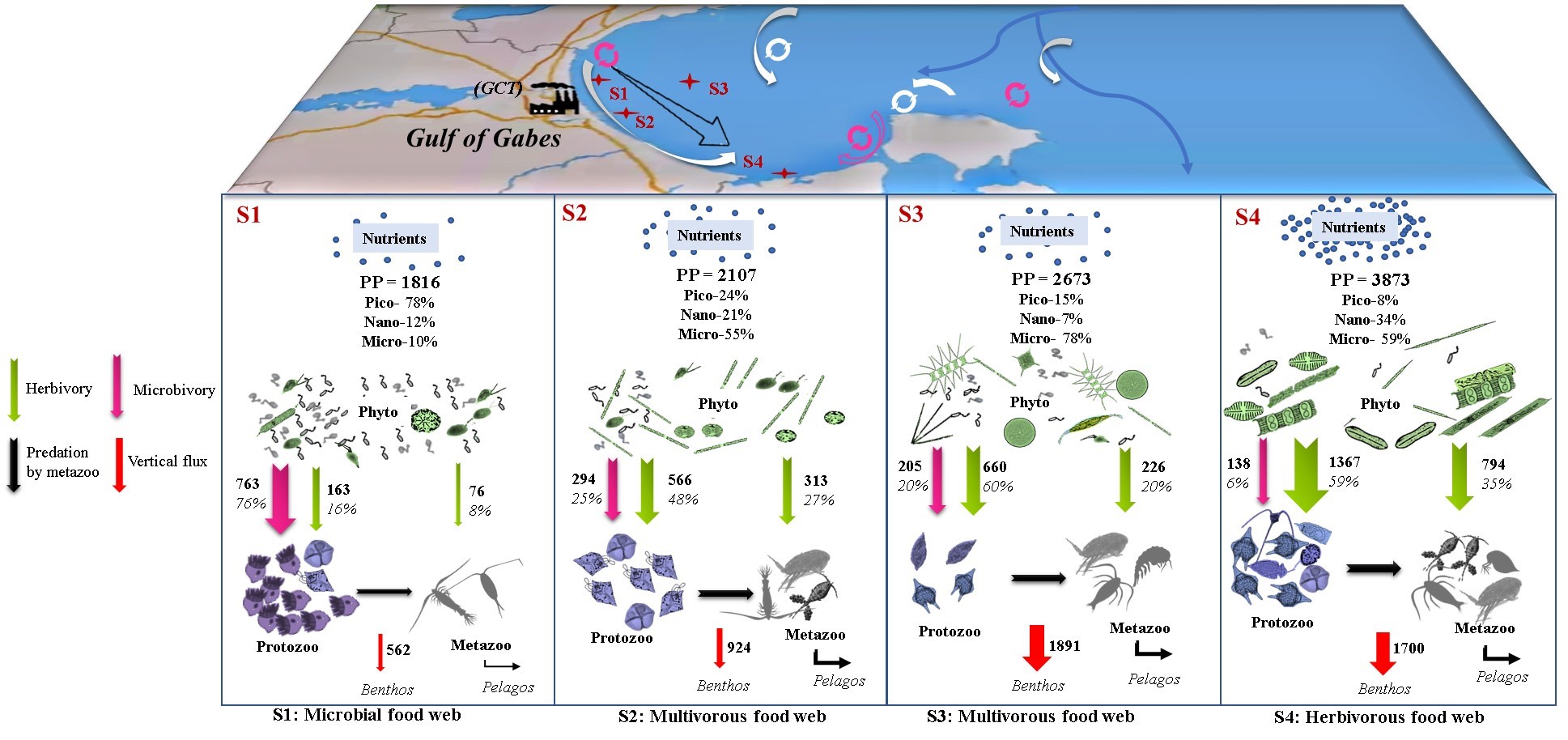Influence of Nutrient Gradient on Phytoplankton Size Structure, Primary Production and Carbon Transfer Pathway in a Highly Productive Area (SE Mediterranean)
Influence of Nutrient Gradient on Phytoplankton Size Structure, Primary Production and Carbon Transfer Pathway in a Highly Productive Area (SE Mediterranean)
Chkili, O., Meddeb, M., Mejri Kousri, K. et al. Influence of Nutrient Gradient on Phytoplankton Size Structure, Primary Production and Carbon Transfer Pathway in a Highly Productive Area (SE Mediterranean). Ocean Sci. J. 58, 6 (2023). https://doi.org/10.1007/s12601-023-00101-6
Nous avons évalué la variabilité spatiale de la structure de taille du phytoplancton, la composition de la communauté, la production primaire et les flux de carbone à travers le réseau trophique planctonique du golfe de Gabès (GG ; mer Méditerranée sud-est) à l'automne 2017 lors de la croisière MERMEX-MERITE. Les concentrations élevées en nutriments, chlorophylle a (~ 2-6 µg L-1) et la production primaire (1816-3674 mg C m-2 d-1) ont révélé un statut eutrophique des stations étudiées dans le GG. Conformément aux caractéristiques hydrodynamiques, les concentrations de nutriments inorganiques ont augmenté du nord au sud et de la côte au large, ces gradients de nutriments ayant un impact sur la distribution spatiale de la communauté phytoplanctonique. La biomasse et la production phytoplanctoniques fractionnées par taille étaient les plus faibles dans la zone la plus au nord, où elles étaient principalement soutenues par la fraction de taille de pico. Parallèlement, dans cette zone, les petits ciliés aloricates étaient dominants, entraînant une microbivorie élevée. Inversement, une biomasse et une production plus élevées ont été mesurées vers le sud et au large avec la prédominance des grandes algues (fractions nano et/ou micro) soutenu par des diatomées. Le protozooplancton et le métazooplancton herbivores étaient plus abondants dans ces zones, ce qui a entraîné une augmentation de l'herbivorie. Le flux vertical de carbone organique particulaire a également suivi un gradient croissant nord-sud et côte-large, avec une plus grande contribution du phytoplancton et des pelotes fécaux du zooplancton à la matière organique descendante dans la zone la plus au sud. Nos résultats suggèrent que même dans les eaux riches en nutriments et hautement productives, un continuum de voies trophiques, allant des réseaux alimentaires microbiens aux réseaux alimentaires multivores et herbivores, peut exister, ce qui implique différentes efficacités dans l'exportation du carbone et la capacité de charge au sein de l'écosystème.
Contact BOREA : Oumayma Chkili oumayma.chkili@unicaen.fr / chkili.oumayma94@gmail.com
Légende illustration :
Primary production (PP, mg C m-2 d-1), trophic relationships and carbon transfer pathways within the planktonic systems of the sampling stations in link with the nutrient spatial gradient and hydrodynamic circulation in the Gulf of Gabès during the fall 2017. Percentage contributions of phytoplankton size fractions to PP are indicated. Values with arrows show the amount of channeled biogenic carbon (mg C m-2 d-1) and percentages represent the contribution of zooplankton microbivory or herbivory to carbon transfer. Width of arrow is proportional to the carbon flow. Microbivory = consumption of Pico by Protozoo; Herbivory = consumption of Nano- and Micro by Protozoo and Metazoo; carbon transfer = consumption of Pico, Nano and Micro by Protozoo and Metazoo. © Oumayma Chkili


